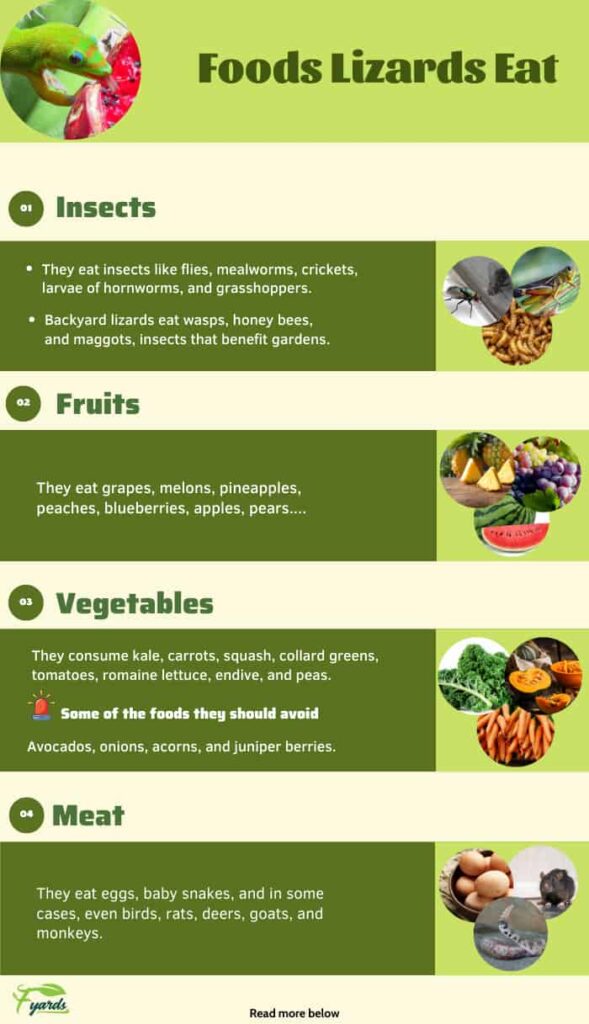Lizards are a diverse group of reptiles that can be found in a wide range of habitats around the world. Their diets are equally diverse, depending on the species and environment. Here is an overview of what wild lizards typically eat.

Insects and Other Invertebrates
The majority of lizards are insectivores, meaning insects make up all or most of their diet. Crickets, grasshoppers, spiders, worms, and caterpillars are common prey. Lizards use their quick reflexes and sticky tongues to capture insects. Some lizard species like the chuckwalla are opportunistic omnivores, eating plants, seeds, and fruits as well as insects.
Small invertebrates like snails, slugs, and scorpions may also be eaten. Larger lizards can tackle bigger prey including crayfish, crabs, and centipedes. Chameleons and other arboreal species often feed on tree-dwelling insects. Anoles target flies, ants, beetles, and termites. Geckos feast on moths, mosquitoes, roaches and more.
Small Vertebrates
While insects are the largest part of lizard’s diet, some lizards supplement with small vertebrates for protein. Swift species like collared lizards and fence lizards prey on smaller lizards, frogs, mice, birds and rodents. Larger lizards like monitors and tegus can take down snakes, turtles, small mammals, fish, and even birds!
Venomous lizards including Gila monsters and beaded lizards use their toxic bites to immobilize rodents and birds. Komodo dragons and other large monitor species can attack larger prey like deer, buffalo, and horses. Marine iguanas graze on algae but sometimes eat crabs and fish. Snakes like racers and coachwhips overpower smaller lizards, amphibians and eggs.
Plants, Fruits and Seeds
Though most lizards eat animal prey, some species supplement their diets by eating plant matter. Iguanas are primarily herbivorous, feeding on leaves, fruits and flowers. Chuckwallas snack on buds, fruits and seeds. Desert species like zebra-tailed lizards eat prickly pear cactus fruits and pads. Some small species like swifts eat pollen and nectar.
Frugivorous lizards help disperse seeds through their droppings. Omnivorous species get fiber, nutrients and moisture from fruits, berries, seed pods and edible flowers. Leafy greens provide hydration in dry areas. Lizards also ingest grit and small rocks to aid digestion.
Habitat and Hunting
A lizard’s habitat and hunting style influences its opportunities for food. In forests and jungles, arboreal lizards like chameleons await passing insects from branches and leaves. Geckos hide under bark and rocks. Swift species like anoles and fence lizards chase prey in open areas.
Desert-dwellers like zebra-tailed lizards feed on sparse vegetation. Marine iguanas graze underwater. Semi-aquatic species like basilisks (“Jesus lizards”) can sprint across water to catch insects and spiders. Nocturnal geckos hunt moths at night. Diurnal lizards bask in the sun then hunt during the day.
Most lizards are ambush predators, waiting patiently for prey to come near. They rely on camouflage and patience. Some are more active foragers, actively pursuing insects and small prey. Monitor lizards and other large species are apex predators in their environments.
Captive Lizards
In captivity, pet lizards are fed a controlled diet according to their needs. Herbivores like iguanas need greens, vegetables, and fruits. Omnivores benefit from a balanced mix of plant and animal foods. Carnivores require a protein-focused diet.
Common feeder insects include crickets, mealworms, roaches, and grasshoppers. Frozen/thawed pinky mice or ground turkey can provide meat. Supplements add key vitamins and minerals. Food should be gut loaded and dusted. Meal plans can be tailored to a lizard’s age and health. Proper hydration is also critical.
Conclusion
In summary, wild lizards fill diverse niches depending on where they live. Most eat insects and invertebrates. Some also eat small vertebrates, fruits, seeds, and greens. Their habitat and natural history shape their dietary adaptations. With proper care, captive lizards can thrive on balanced, nutrient-rich diets. What a lizard eats provides a fascinating glimpse into its ecology and evolution.
FAQs About What Does a Wild Lizard Eat
How do wild lizards catch their prey?
Wild lizards use a variety of strategies to catch prey. Many employ stealth and patience, ambushing insects or small animals that come within striking distance. Others, like chameleons, have projectile tongues that rapidly snatch insects from a distance. Each species has adapted its hunting technique to its unique environment and prey.
Are there any specific foods that wild lizards avoid?
While the dietary preferences of wild lizards vary, some common avoidances include toxic or bitter-tasting insects and plants. Lizards often rely on their keen sense of smell and taste to assess potential food items. Avoidance of toxic prey is a survival strategy that helps prevent illness or poisoning.
Can wild lizards eat larger animals?
Generally, wild lizards focus on smaller prey that they can handle and digest. However, larger lizard species or those with specific adaptations might consume relatively larger animals. For example, some monitor lizard species can eat birds, rodents, or even small mammals, utilizing their size and strength to do so.
What role does diet play in the lizard’s ecosystem?
Diet plays a significant role in a lizard’s ecosystem. As both predators and prey, lizards help control insect populations, influencing the overall balance of their environment. Additionally, their food choices can impact plant pollination when they feed on nectar or carry pollen between flowers, contributing to ecosystem health.
How often do wild lizards need to eat?
The frequency of wild lizards’ feeding varies based on factors like species, size, metabolism, and food availability. Some lizards feed daily, while others might eat less frequently due to their slower metabolism. Efficient energy utilization allows them to adapt their feeding habits to the resources and conditions of their habitat.



